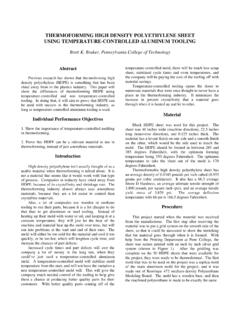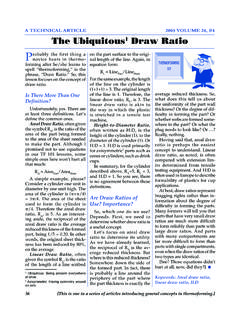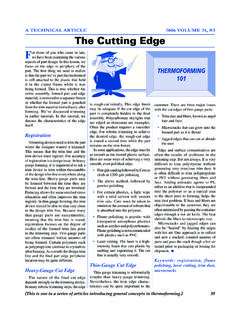Transcription of A TECHNICAL ARTICLE 2006 VOLUME 25, #3 The Cutting Edge
1 A TECHNICAL ARTICLE 2006 VOLUME 25, #3. The Cutting Edge F or those of you who came in late, we have been examining the various aspects of part design. In this lesson, we focus on the edge or periphery of the part. The first thing we need to realize THERMOFORMING. is that the part we've just thermoformed is still attached to the plastic that held 101. it in the clamp frame while it was being formed. This is true whether the entire assembly, formed part and edge material, is removed to a separate fixture or whether the formed part is punched is rough-cut initially. This edge finish customer. There are three major issues from the trim material immediately after may be adequate if the cut edge of the with the cut edges of thin-gauge parts: forming. We've discussed trimming part is completely hidden in the final in earlier tutorials. In this tutorial, we assembly. Polycarbonate skylights that Trim dust and fibers, known as angel discuss the characteristics of the edge are edged in aluminum are examples.
2 Hair and fuzz. itself. Often the product requires a smoother Microcracks that can grow into the edge. For robotic trimming to achieve formed part as it is flexed Registration the desired edge, the rough-cut edge Jagged edges that can cut or abrade Trimming devices need to trim the part is routed a second time while the part the user where the designer wanted it trimmed. remains on the trim fixture. This means that the trim line and the In some applications, the edge must be Edge and surface contamination are trim device must register. The accuracy as smooth as the overall plastic surface. often the results of problems in the of registration is a design issue. In heavy Here are some ways of achieving a very trimming step. But not always. It is very gauge forming, it is impractical to ask a smooth, even polished edge. difficult to trim polystyrene without trim device to trim within thousandths Fine grit sanding followed by Crocus generating very tenacious trim dust.
3 It of the design trim line everywhere along cloth or 1200-grit polishing is often difficult to trim polypropylene the trim line. Heavy-gauge parts may or PET without generating fibers and The above method, followed by fuzz. Adding antistatic agents to PS, be fixtured between the time they are pumice polishing either as an additive that is compounded formed and the time they are trimmed. Fixturing allows for some residual stress For certain plastics, a light wipe into the polymer or as a topical coat relaxation and often improves the trim with a mild solvent will smooth to the sheet prior to forming, helps the registry. In thin-gauge forming, the trim trim cuts. Care must be taken to trim dust problem. If fuzz and fibers are device should be able to trim very close minimize the amount of solvent that objectionable to the customer, they are to the design trim line. Because many is absorbed into the polymer. often minimized by passing the container thin gauge parts are axisymmetric, edges through a hot air knife.
4 The heat Flame-polishing is popular with meaning that the trim line is round, shrivels the fibers to microscopic size. transparent amorphous plastics registration focuses on the degree of Microcracks and jagged edges can such as acrylics and polycarbonates. ovality of the formed trim line prior also be healed by heating the edges Flame-polishing is not recommended to the trimming step. Thin-gauge parts with hot air. One approach is to collect with plastics such as PVC. are often trimmed within minutes of and nest a stacked, counted number of being formed. Certain polymers such Laser Cutting . The laser is a high- parts and pass the stack though a hot air as polypropylene continue to crystallize intensity beam that cuts plastic by tunnel prior to packaging or boxing for after forming. As a result, the design trim melting and vaporizing it. The cut shipment.. line and the final part edge peripheral line is usually very smooth. location may be quite different.
5 Keywords: registration, flame Thin-Gauge Cut Edge polishing, laser Cutting , trim dust, Heavy-Gauge Cut Edge Thin-gauge trimming is substantially microcracks The nature of the final cut edge simpler than heavy-gauge trimming. depends strongly on the trimming device. Nevertheless, the trim edge charac- In many robotic trimming steps, the edge teristics can be quite important to the [This is one in a series of articles introducing general concepts in thermoforming.] 39. TF101 Insides 39 9/25/07 8:55:51 AM.




